
If you wish you had a blog, you're probably not alone. If you feel like you never have time to write, you're definitely not alone. When content marketing isn't your forte, it can be tough to know where to start. Hey - I can't just whip up a financial model for a real estate deal in an hour. We all have our strengths and weaknesses.
I want to outline a simple process anyone can follow to come up with content ideas --interesting content ideas, for their blog or website. There are few other marketing efforts that allow you to attract prospects in so many different ways.
Content Marketing Puts You In The Triple Threat Position
If you played organized basketball past the 3rd grade, you might be familiar with Triple Threat Position.
For those that don't know, this is a stance you position yourself in while on offense. You position yourself in such a way that you could do any 1 of 3 things: dribble, pass or shoot. Having good content on your website and a good content marketing strategy is not much different.
Content marketing allows you to:
- Attract organic traffic to your website
- Post content you own on social media that bring people back to you website
- Have interesting content to distribute via email and in B2B lead nurturing
- Build a brand known for its subject matter expertise.
That's right - 4 benefits - there's a bonus benefit. Content marketing is the new brand marketing and the best investment you can make to your brand.
Content Marketing Strategy Step 1: Start at the bottom of your funnel
When you're just getting started with content marketing, begin at the bottom of your funnel. Why? Because initially, you want to attract the people who already know they need your product or service. To illustrate, here is an example funnel to refer back to.
Just focus on "Decision" for now.
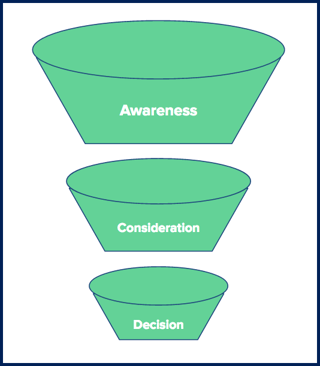
To start, type out a list, ideally in Google Sheets or Excel, of how someone might describe your product or service. Here are some examples:
- If you are Core Health and Fitness, you might want to type in "Commercial Fitness Equipment"
- If you are PlantLink, type in "Watering Sensor", "Automated Garden Watering System" or "Garden Hose Valve"
- If you are Cheer Tumbling Dynamics, type out ways to describe "cheerleading coaching", "cheer camps" or "cheerleading team training"
Next, take your list of the terms and go to Adwords. There are plenty of keyword tools on the market. I have paid to use MozPro and Spyfu. But you probably want a free version, and I would suggest starting by creating a Google Adwords account.
If you have not done so already, create your Google Adwords account. NOT because you need to start running ads, but because you want to make use of Keyword Planner.
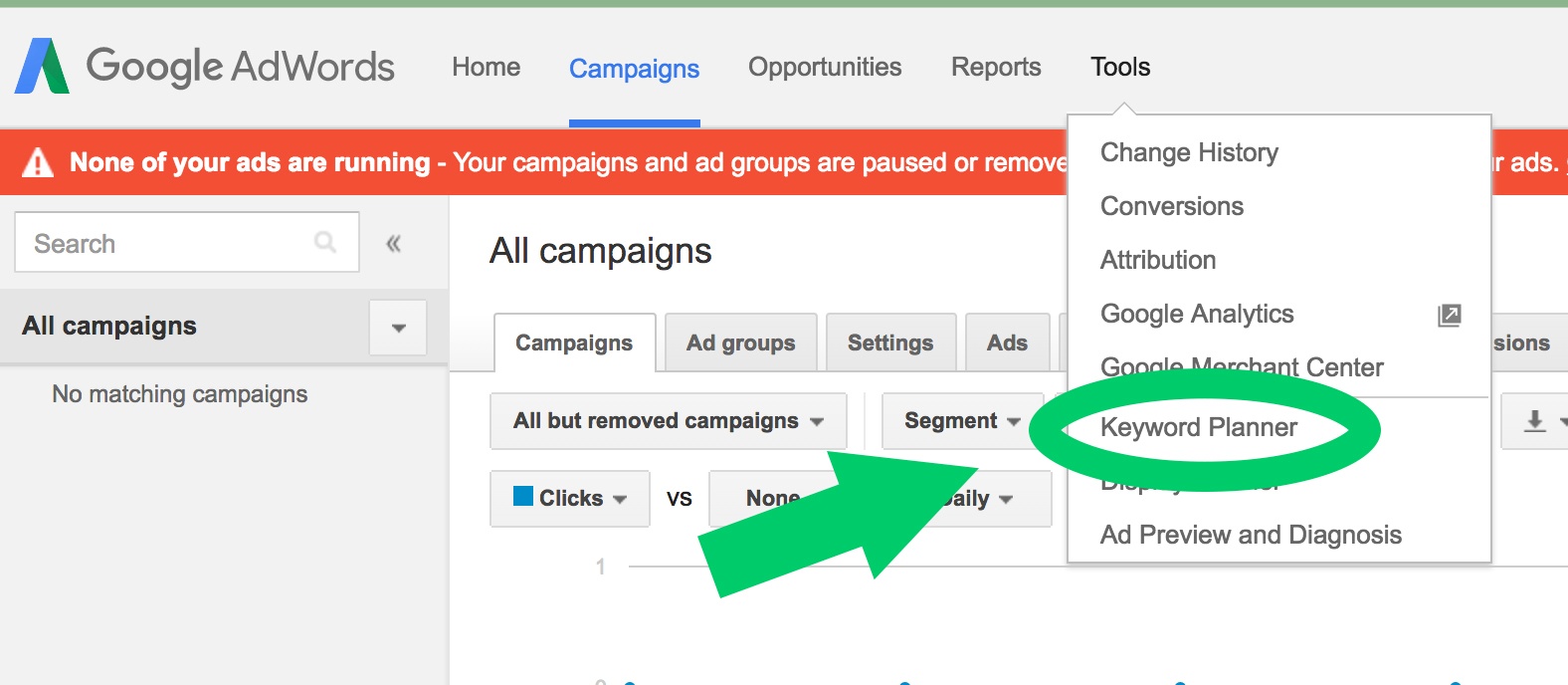
Once your account is set up, head to Tools in the navigation bar, initiate the drop down menu and click "Keyword Planner".
Now, enter in one term to begin searching:
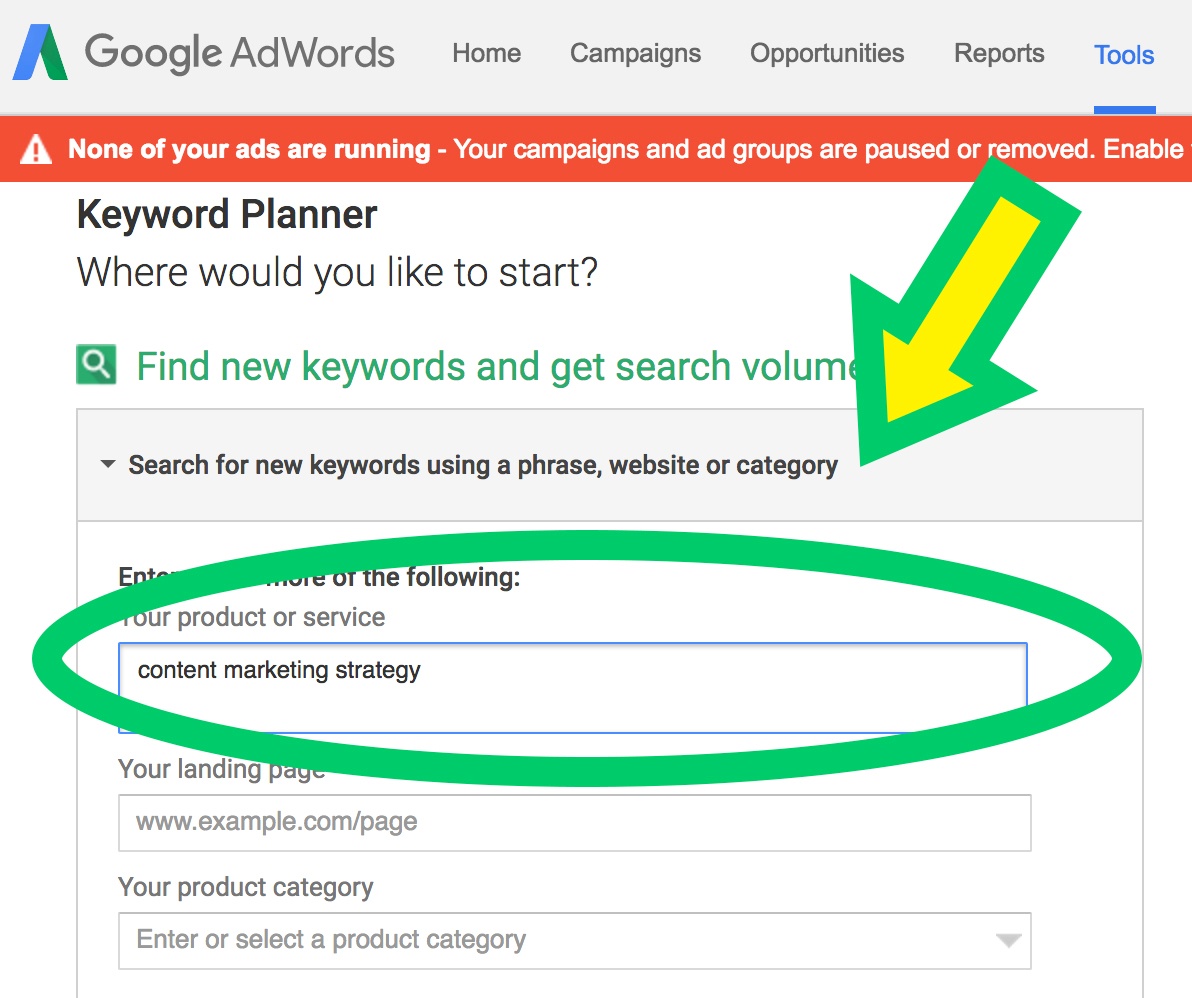
Now, click the "Get Ideas" button:
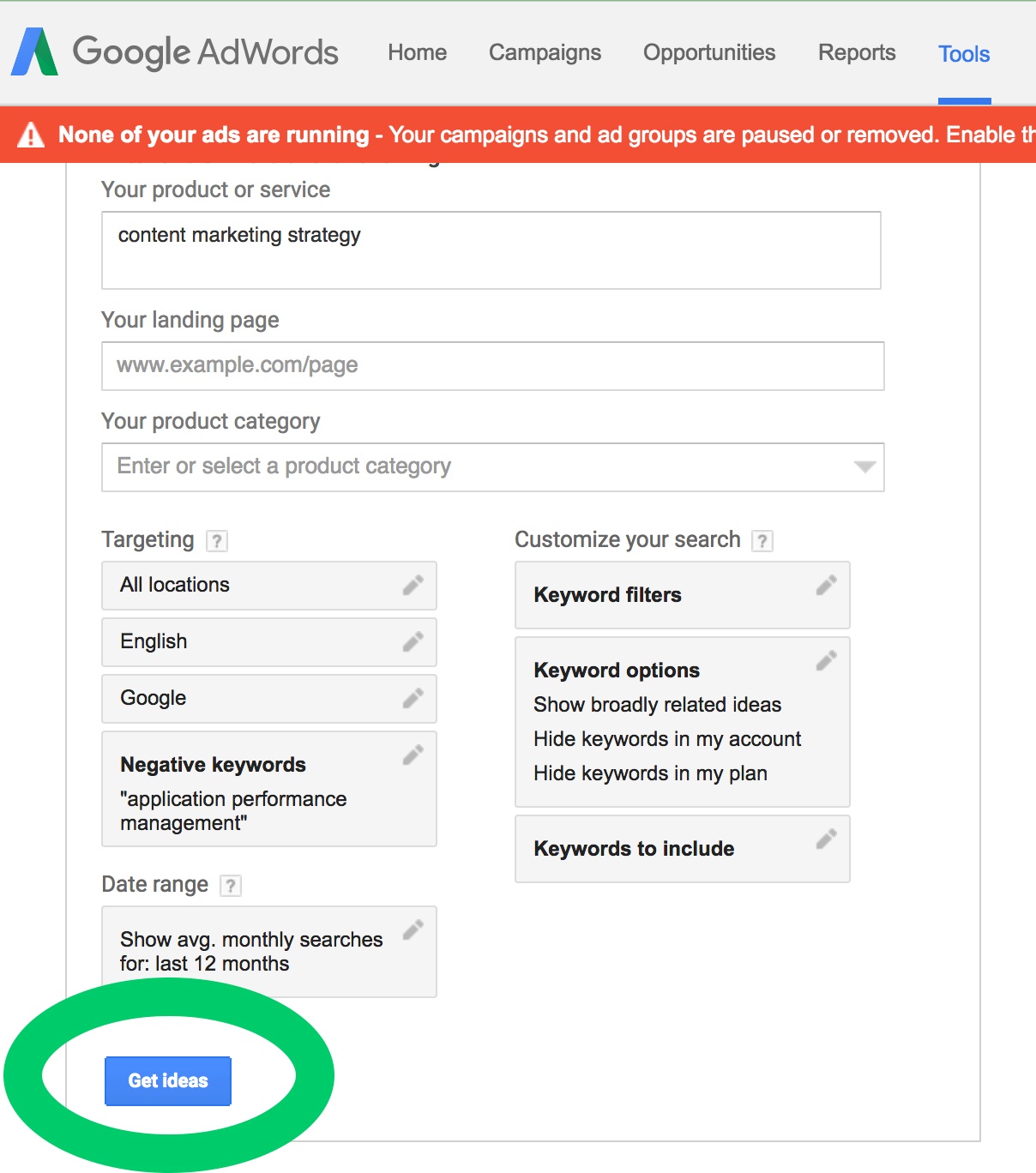
Step 2: Take your list of keywords and use them to come up with article titles
Just start with one key term. The point here is to come up with ideas, which the keyword planner will do for you. As you examine the list of terms, you should start to come up with ideas based on the search results you see.
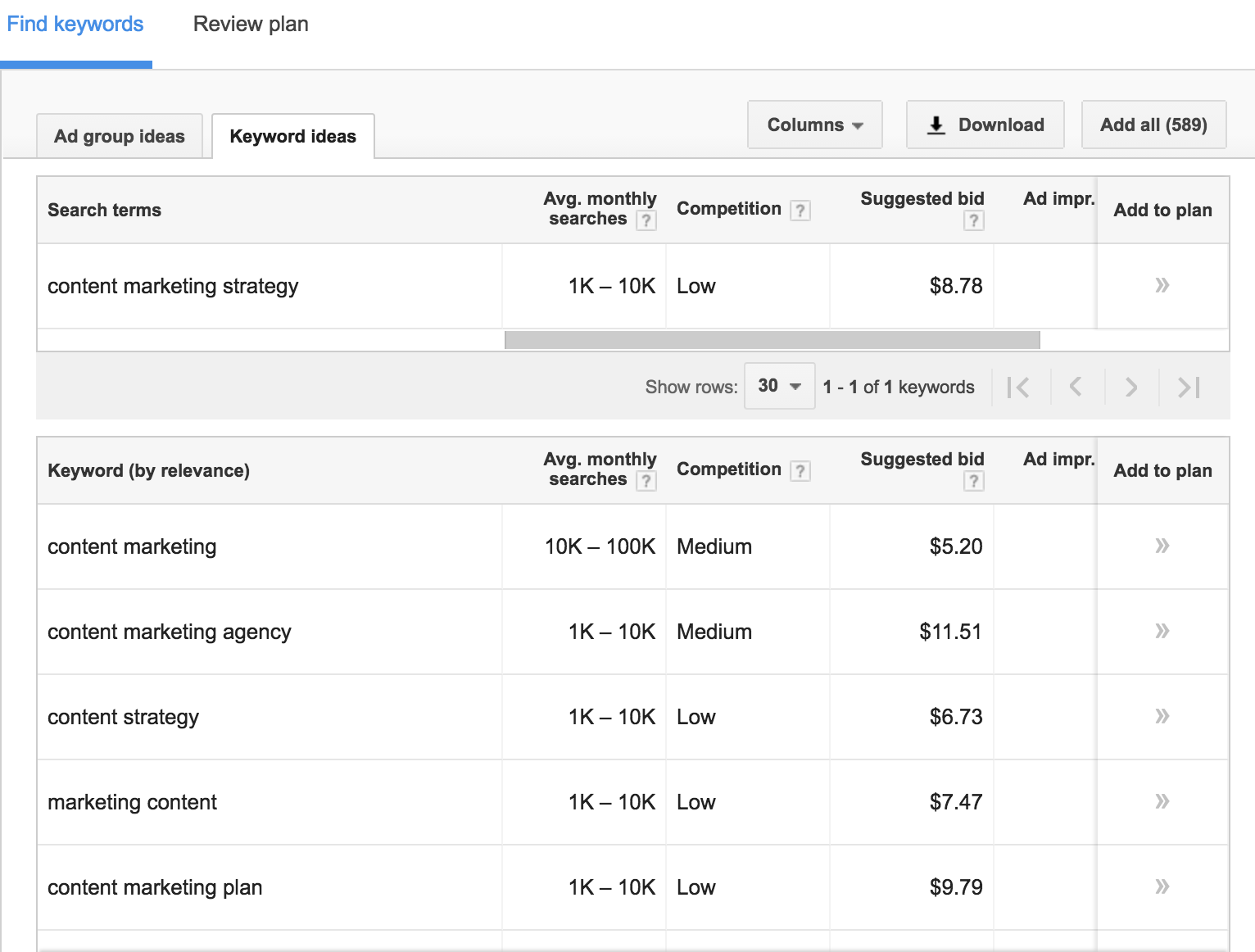
I could write a whole post on what this page tells you, but, for the exercise of coming up with ideas, scroll through your list of keywords that keyword planner has found for you. When you see a term you like, click the "add to plan" double horizontal chevron to add it to a folder.
(Note: I prefer to start in the "Keyword Ideas" tab. Be careful of Ad Group Ideas, as this is a rough approximation of potential ad groups using Broad match selection.)
Understanding your keyword returns is a lot like understanding the market price for fish, or for anything really. A higher price means higher demand relative to the supply of ad units. The higher the suggested bid, the more valuable the broader market finds that particular term. This is a direct indication of what terms are going to be hardest to eventually rank for.
You may want to do additional searches based on ideas that come to you as you review the first batch of potential keywords. You should start to notice nuances in potential keywords and in topics people routinely search for. Once you've finished searching through the 800 or so potential Export your list of keywords into a CSV.
Next, open your CSV. Arrange the columns so there is an open column next to the column containing your selected keywords. Start writing out article ideas using the keyword in the same row.
Try this format to start:
| Keyword | Article Title |
| Content marketing strategy | Content Marketing Strategy: 3 Steps Anyone Can Use to Create Content |
| Commercial Fitness Equipment | Commercial Fitness Equipment: How to Arrange Machines for 25 Minute Circuit Training |
| Self Watering Garden | Self Watering Garden: The Cant-Miss Advantages for Today's Gardening Enthusiasts |
See how I did that? I prefer to include the keyword at the start of a title whenever possible.
Let's focus on PlantLink to finish illustrating how you can come up with a list of blog articles to write. Now, to start attracting traffic at the bottom of the funnel, those who are already looking for a "Self Watering Garden", you can write something like this:
Self-Watering Garden: The Cant-Miss Advantages for Today's Gardening Enthusiasts
In this article, you will want to speak directly about the advantages that come with having a self-watering garden. Use a list format. Try to keep the list to 3 or 4 items where you have a subhead headline for each list item, and 250-300 words per list item. This keeps the content skimmable while still offering value. You don't have to write an essay worthy of being published in The Atlantic. At least not starting out.
Now if you are thinking, "there are only so many ways I could write about a self-watering garden", you are right. You probably don't want 12 articles on that topic. Not only that but you really only want one great article written for each keyword phrase you want to rank for.
Content marketing idea development for "consideration" and "awareness" stages of the funnel
So what about the other stages of the funnel? Consideration and Awareness? Let's take the term "Easy plants to grow" as an example. This term would fall into "Awareness" because we can surmise that the person searching for this term is looking for ideas for plants. They haven't indicated they are having trouble remembering to water plants, or they haven't looked for a specific piece of hardware. But they may be more of a beginning gardener. Would an experienced gardener need help identifying plants that are easy to grow? Probably not.
But what's great about this term, "Easy plants to grow" is that it easily becomes a list, and it will spur growth (sorry) of offshoot topics.
So, we take our keyword phrase "Easy plants to grow" and add our article title:
"Easy plants to grow: 4 plants that take minimal effort to turn into something beautiful."
Your article will then need to feature 4 separate plants that grow and give an overview on how to grow each.
This is where the offshoot ideas will come out. You could focus only on plants, but what about flowers? Vegetables? Shrubs? Potted plants? What about seasonal plants? You could alter the original title of the article to focus on any four members of any of those groups.
What you'll end up doing, is researching specifics on how to grow certain types of flowers, plants, vegetables or shrubs, which will help you come up with even more ideas to write out and prioritize.
In developing a content marketing plan for PlantLink, we found that "automatic watering device" was just the start. We realized we could eventually develop content on a whole host of alternative but related categories:
| Grass | Watering Techniques |
| Soil | Landscaping |
| Flowers | Fruits & Vegetables |
| Potted Plants | Seasonality |
How many separate but related categories can will you end up developing content about?
Step 3: Prioritize the articles you want to write based on stage of funnel and search volume for the term
Speaking of prioritization, we should definitely cover that before the end of this article. How should you prioritize creation of your article ideas? The correct answer is, there are many many variables that can dictate the order. It really depends on your situation.
But that's not an answer that helps you here.
For you to prioritize your content marketing strategy and which blog articles you to create and when, you'll want to understand search volume and the difference between "short tail" and "long tail" search terms.
What to remember with avg monthly search volume
Search volume, or "avg. monthly searches" is just that, an avg of the monthly searches for the term.

There's a pretty big range in search volume for "content marketing", which can make your life harder (hence why there are keyword search tools you can pay for that offer more than Google Keyword Planner).
Just because a keyword is searched for more often does not mean you want to try and rank for it.
Content marketing keywords: Understanding "Short tail" vs "long tail"
Short tail and long tail keywords are just shorter and longer search terms entered into Google. The shorter the term, the more queries. The longer the term, generally the fewer queries there are.
So write everything for short tail terms, right? Not so fast. Short tail terms are much more broad in nature. I certainly don't want to try and get this blog to rank for "content". It's too broad.
Now, if I continue to drill down for longer tail terms like, "content marketing agency b2b Chicago", It's more certain that I will capture the right kind of traffic for me. There are fewer searches for that term, but I don't need all the traffic in the world. I need the "right traffic" in the world.
You don't need more traffic - you need the right kind of traffic.
As you review the keyword term suggestions and start to understand their relative search volume and suggested bid, you will prioritize content creation on these factors, but also on how comfortable you are with creating content on a particular topic.
Don't underestimate your own comfort writing on a topic. If you don't write frequently, you might want to write on something that's not a top priority for you but is something you have a lot of knowledge about. You can use the first topic to get your writing juices going.
Then, as writing becomes more of a habit, you can dig into tougher topics. Above all else, remove barriers to getting started creating content while still being smart about how your content will drive inbound traffic.


